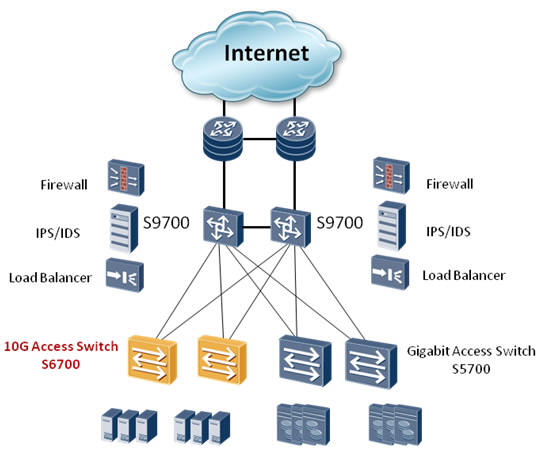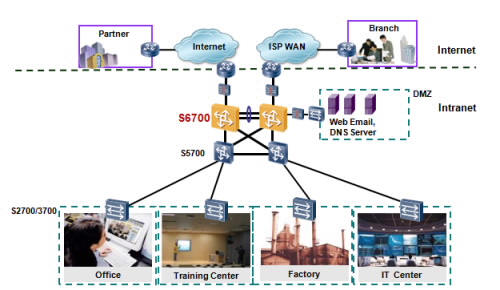The S7700 series enterprise switches (S7700s) are high-end smart routing switches, which can function either as an aggregation or core node on a campus network to provide integrated wireless access or as an aggregation node in a data center.Based on carrier-class design, each S7700 switch supports 480x 10GE ports and can deliver 99.999% reliability in any enterprise environment. This high density of 10GE ports and high uptime, along with the ability to integrate voice, video, data and wireless services, helps enterprises build integrated, full-service networks and bring their campus and data centers into the era of the all 10GE core network.
Large capacity and high density 10Gbps access, the S6700 supports up to a maximum of 48 line-speed 10GE ports and can be deployed in a data center to provide 10Gbps access to servers, or function as a core switch on a campus network to provide 10Gbps traffic aggregation. The S6700 Series of switches also provide a wide variety of services, comprehensive security policies, and various QoS features to help customers build scalable, manageable, reliable, and secure data centers
|
Item
|
S6700-24-EI
|
S6700-48-EI
|
|
Port |
24* GE SFP/10 GE SFP+ ports |
48* GE SFP/10 GE SFP+ ports |
|
MAC address table |
128K MAC address entries |
|
|
VLAN |
4K VLANs |
|
|
IPv4 routing |
Static routing, RIPv1, RIPv2, ECMP, and URPF |
|
|
IPv6 routing |
Static route |
|
|
IPv6 features |
Neighbor Discovery (ND) |
|
|
multicast |
Static Layer 2 multicast MAC address |
|
|
QoS/ACL |
Rate limiting on packets sent and received by an interface |
|
|
Reliability |
STP(IEEE 802.1d), RSTP(IEEE 802.1w), and MSTP(IEEE 802.1s) |
|
|
Security |
DoS attack defense, ARP attack defense, and ICMP attack
defense |
|
|
Management and maintenance |
iStack (using service ports as stack ports) |
|
|
Operating environment |
Operating temperature: 0OC–45OC |
|
|
Input voltage |
AC: |
|
|
Dimensions (W x D x H) |
442 mm x 420 mm x 43.6 mm |
|
|
Power consumption |
153W |
240W |
For more details, please refer to
S6700
datasheet.
The S6700 can be used in Huawei's sustainable data center
solution, which has four major highlights: evolution, availability,
pooling, and visualization.
As shown in the following figure, the S9700 Terabit routing switches
function as core switches in a data center and use firewall and load
balancer boards to ensure security and perform load balancing. The
S6700s function as access switches and provide high-density 10GE
ports to connect to 10G servers.

The S6700 can function as a core switch on a campus network and provide high-density line-speed 10GE ports, rich service features, and comprehensive security mechanisms. This makes the S6700 a cost-effective option

| Product Description | ||||
|---|---|---|---|---|
| S6700-24-EI Mainframe (24 x 10 GE SFP+, Dual Slots of power, without Power Module) | ||||
| S6700-48-EI Mainframe (48 x 10 GE SFP+, Dual Slots of power, without Power Module) | ||||
| 500W AC Power Module | ||||
| 500W DC Power Module | ||||
| Vendor | Product | Description | Huawei Advantages |
|---|---|---|---|
| HUAWEI | S6700-48-EI | 48 10GE SFP+, Dual Slots of Power, Without Power Module | |
| CISCO | C4500X-32SFP+ | Catalyst 4500-X 32 Port 10GE, Support one 8 Port 10GE Module, Suport Front-to-Back or Back-to-Front Cooling, Support IP Base or Enterprise Services Software Image | High-density 10G ports (48 vs 32); large MAC address table (128K vs 55K); ring network protocols SEP and G.8032 |
| Vendor | Product | Description | Huawei Advantages |
|---|---|---|---|
| HUAWEI | S6700-24-EI | 24 10GE SFP+, Dual Slots of Power, Without Power Module | |
| CISCO | C4500X-16SFP+ | Catalyst 4500-X 16 Port 10GE, Support one 8 Port 10GE Module, Suport Front-to-Back or Back-to-Front Cooling, Support IP Base or Enterprise Services Software Image | High-density 10G ports (24 vs 16); large MAC address table (128K vs 55K); ring network protocols SEP and G.8032 |
| HP/H3C | S5820X-26S | HP JG219A 5820AF-24XG. MPLS L2/L3 VPN 10G Switch. 24 1/10G SFP+ Ports, and 2 10/100/1000Base-T Ports. Support Front-to-Back or Back-to-Front Cooling. | Large MAC address table (128K vs 32K); high reliability, supporting ring network protocols SEP and G.8032 |
| HP/H3C | S5820X-28C | HP JC106A 5820-14XG-SFP with 2 Slots. MPLS L2/L3 VPN 10G Switch. 2RU Height. 14 1/10G SFP+ Ports, and 4 10/100/1000Base-T Ports and 2 Interface Slots and 1 OAP Slot. Interface Slot support 4-port 8/4/2 Gbps FCoE SFP+ Module (JC530A), 4-port 10GbE SFP+ Module (JC091A), 2-port 10GbE SFP+ Module (JC092B). OAP Slot support VPN Firewall Module (JD255A). | Large MAC address table (128K vs 32K); high reliability, supporting ring network protocols SEP and G.8032 |
| HP/H3C | S5820X-28S | HP JC102A 5820-24XG-SFP+. MPLS L2/L3 VPN 10G Switch. 24 1/10G SFP+ Ports, and 4 10/100/1000Base-T Ports. | Large MAC address table (128K vs 32K); high reliability, supporting ring network protocols SEP and G.8032 |